Working Scientifically Essay 2022
VerifiedAdded on 2022/09/29
|10
|2633
|38
Essay
AI Summary
Contribute Materials
Your contribution can guide someone’s learning journey. Share your
documents today.
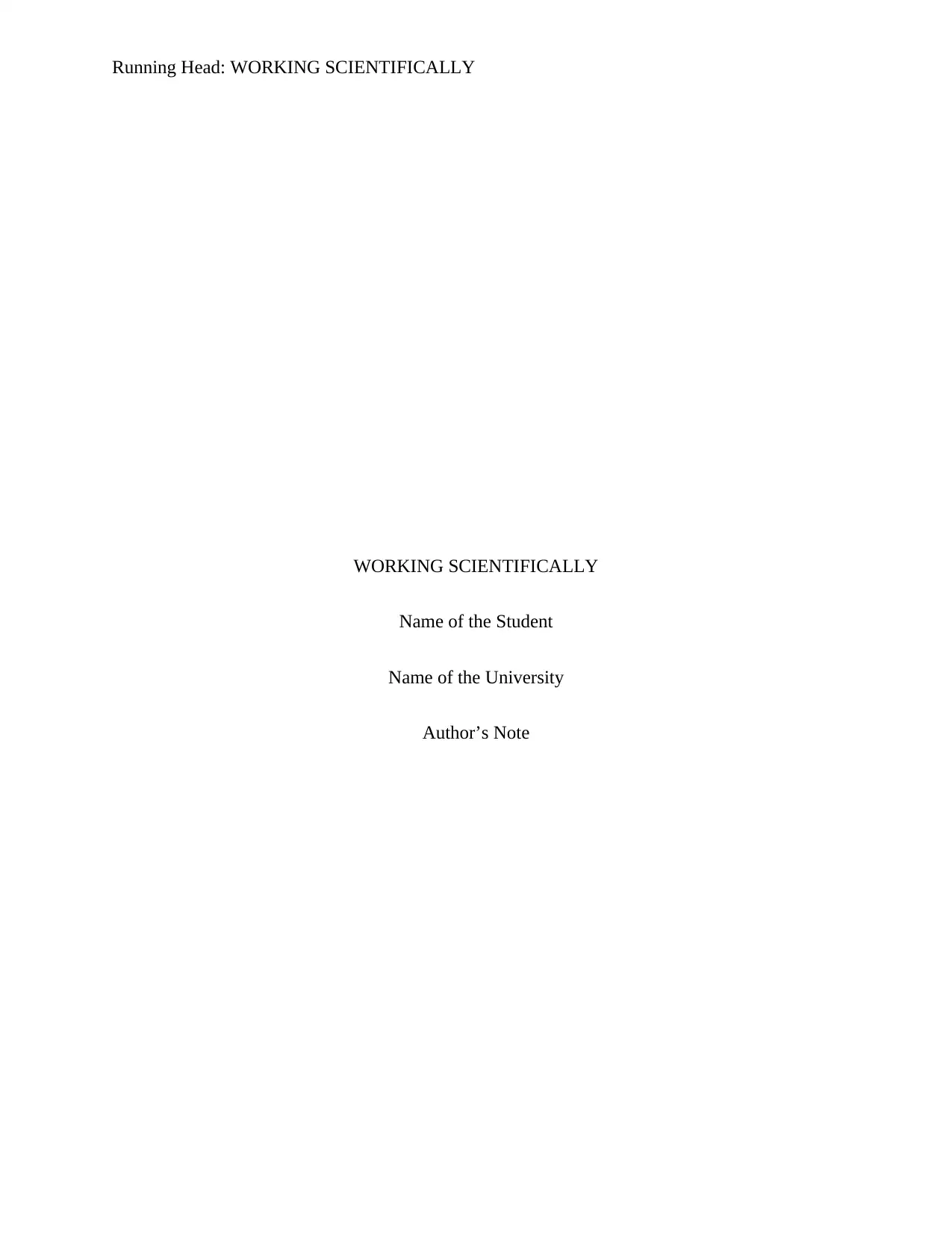
Running Head: WORKING SCIENTIFICALLY
WORKING SCIENTIFICALLY
Name of the Student
Name of the University
Author’s Note
WORKING SCIENTIFICALLY
Name of the Student
Name of the University
Author’s Note
Secure Best Marks with AI Grader
Need help grading? Try our AI Grader for instant feedback on your assignments.
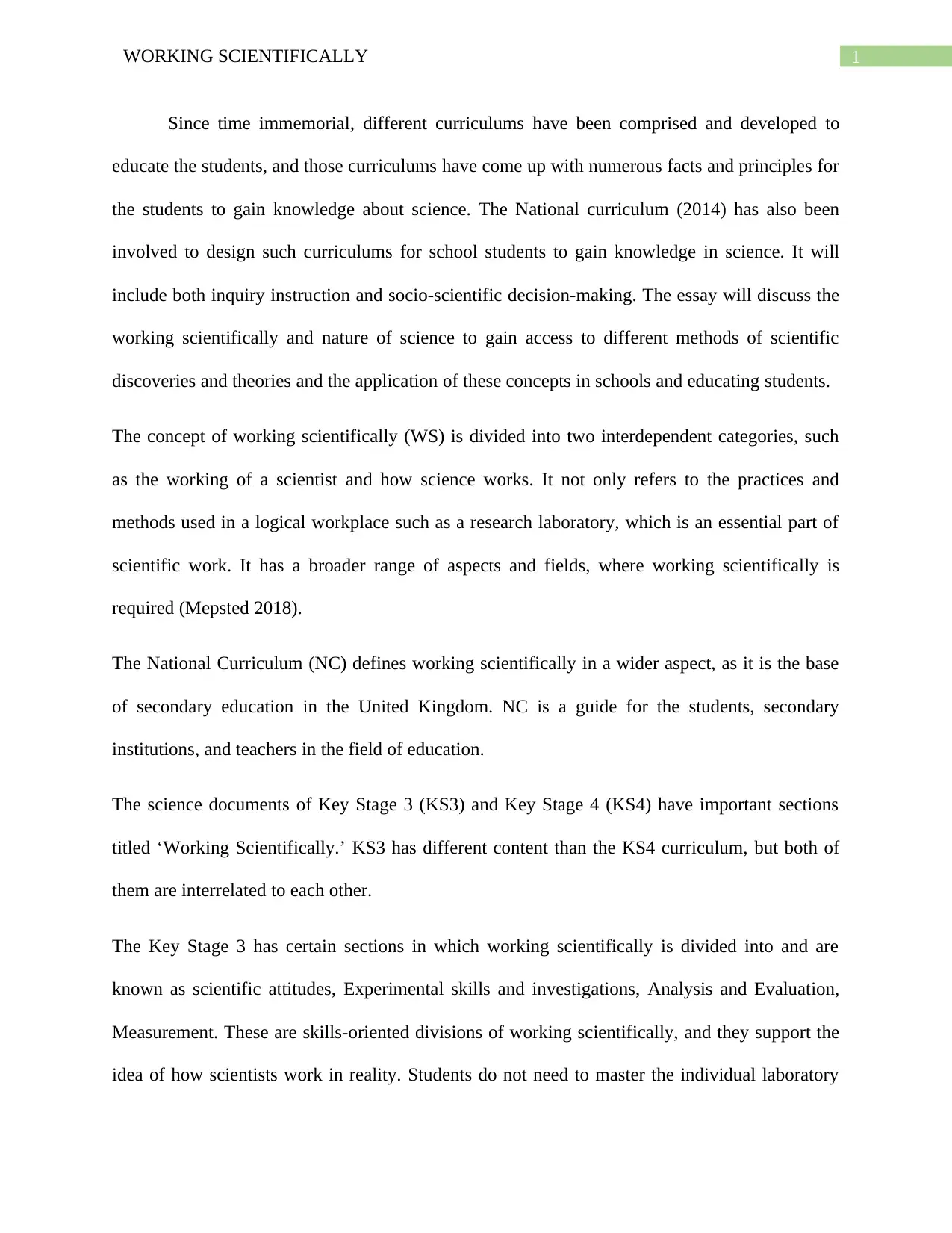
1WORKING SCIENTIFICALLY
Since time immemorial, different curriculums have been comprised and developed to
educate the students, and those curriculums have come up with numerous facts and principles for
the students to gain knowledge about science. The National curriculum (2014) has also been
involved to design such curriculums for school students to gain knowledge in science. It will
include both inquiry instruction and socio-scientific decision-making. The essay will discuss the
working scientifically and nature of science to gain access to different methods of scientific
discoveries and theories and the application of these concepts in schools and educating students.
The concept of working scientifically (WS) is divided into two interdependent categories, such
as the working of a scientist and how science works. It not only refers to the practices and
methods used in a logical workplace such as a research laboratory, which is an essential part of
scientific work. It has a broader range of aspects and fields, where working scientifically is
required (Mepsted 2018).
The National Curriculum (NC) defines working scientifically in a wider aspect, as it is the base
of secondary education in the United Kingdom. NC is a guide for the students, secondary
institutions, and teachers in the field of education.
The science documents of Key Stage 3 (KS3) and Key Stage 4 (KS4) have important sections
titled ‘Working Scientifically.’ KS3 has different content than the KS4 curriculum, but both of
them are interrelated to each other.
The Key Stage 3 has certain sections in which working scientifically is divided into and are
known as scientific attitudes, Experimental skills and investigations, Analysis and Evaluation,
Measurement. These are skills-oriented divisions of working scientifically, and they support the
idea of how scientists work in reality. Students do not need to master the individual laboratory
Since time immemorial, different curriculums have been comprised and developed to
educate the students, and those curriculums have come up with numerous facts and principles for
the students to gain knowledge about science. The National curriculum (2014) has also been
involved to design such curriculums for school students to gain knowledge in science. It will
include both inquiry instruction and socio-scientific decision-making. The essay will discuss the
working scientifically and nature of science to gain access to different methods of scientific
discoveries and theories and the application of these concepts in schools and educating students.
The concept of working scientifically (WS) is divided into two interdependent categories, such
as the working of a scientist and how science works. It not only refers to the practices and
methods used in a logical workplace such as a research laboratory, which is an essential part of
scientific work. It has a broader range of aspects and fields, where working scientifically is
required (Mepsted 2018).
The National Curriculum (NC) defines working scientifically in a wider aspect, as it is the base
of secondary education in the United Kingdom. NC is a guide for the students, secondary
institutions, and teachers in the field of education.
The science documents of Key Stage 3 (KS3) and Key Stage 4 (KS4) have important sections
titled ‘Working Scientifically.’ KS3 has different content than the KS4 curriculum, but both of
them are interrelated to each other.
The Key Stage 3 has certain sections in which working scientifically is divided into and are
known as scientific attitudes, Experimental skills and investigations, Analysis and Evaluation,
Measurement. These are skills-oriented divisions of working scientifically, and they support the
idea of how scientists work in reality. Students do not need to master the individual laboratory
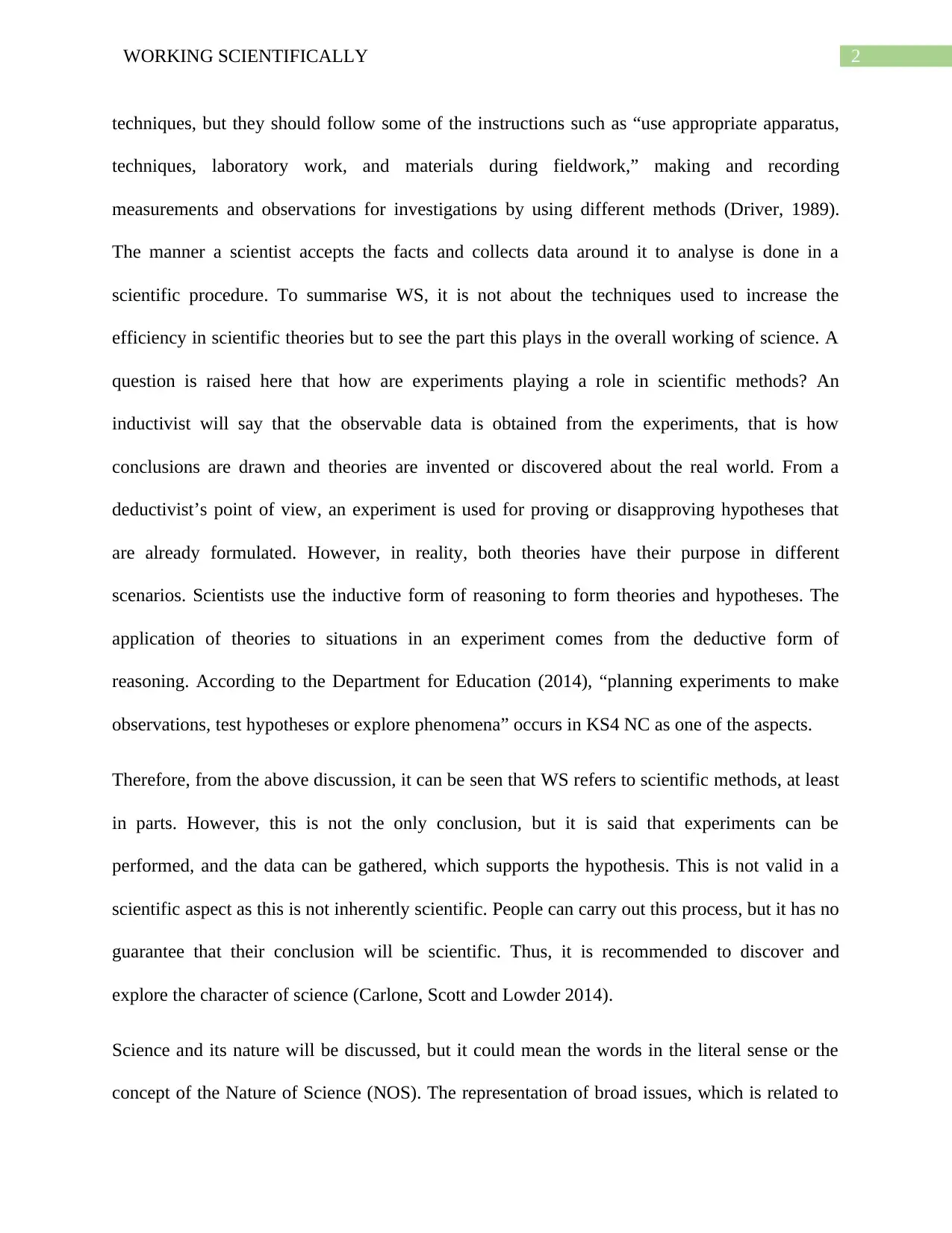
2WORKING SCIENTIFICALLY
techniques, but they should follow some of the instructions such as “use appropriate apparatus,
techniques, laboratory work, and materials during fieldwork,” making and recording
measurements and observations for investigations by using different methods (Driver, 1989).
The manner a scientist accepts the facts and collects data around it to analyse is done in a
scientific procedure. To summarise WS, it is not about the techniques used to increase the
efficiency in scientific theories but to see the part this plays in the overall working of science. A
question is raised here that how are experiments playing a role in scientific methods? An
inductivist will say that the observable data is obtained from the experiments, that is how
conclusions are drawn and theories are invented or discovered about the real world. From a
deductivist’s point of view, an experiment is used for proving or disapproving hypotheses that
are already formulated. However, in reality, both theories have their purpose in different
scenarios. Scientists use the inductive form of reasoning to form theories and hypotheses. The
application of theories to situations in an experiment comes from the deductive form of
reasoning. According to the Department for Education (2014), “planning experiments to make
observations, test hypotheses or explore phenomena” occurs in KS4 NC as one of the aspects.
Therefore, from the above discussion, it can be seen that WS refers to scientific methods, at least
in parts. However, this is not the only conclusion, but it is said that experiments can be
performed, and the data can be gathered, which supports the hypothesis. This is not valid in a
scientific aspect as this is not inherently scientific. People can carry out this process, but it has no
guarantee that their conclusion will be scientific. Thus, it is recommended to discover and
explore the character of science (Carlone, Scott and Lowder 2014).
Science and its nature will be discussed, but it could mean the words in the literal sense or the
concept of the Nature of Science (NOS). The representation of broad issues, which is related to
techniques, but they should follow some of the instructions such as “use appropriate apparatus,
techniques, laboratory work, and materials during fieldwork,” making and recording
measurements and observations for investigations by using different methods (Driver, 1989).
The manner a scientist accepts the facts and collects data around it to analyse is done in a
scientific procedure. To summarise WS, it is not about the techniques used to increase the
efficiency in scientific theories but to see the part this plays in the overall working of science. A
question is raised here that how are experiments playing a role in scientific methods? An
inductivist will say that the observable data is obtained from the experiments, that is how
conclusions are drawn and theories are invented or discovered about the real world. From a
deductivist’s point of view, an experiment is used for proving or disapproving hypotheses that
are already formulated. However, in reality, both theories have their purpose in different
scenarios. Scientists use the inductive form of reasoning to form theories and hypotheses. The
application of theories to situations in an experiment comes from the deductive form of
reasoning. According to the Department for Education (2014), “planning experiments to make
observations, test hypotheses or explore phenomena” occurs in KS4 NC as one of the aspects.
Therefore, from the above discussion, it can be seen that WS refers to scientific methods, at least
in parts. However, this is not the only conclusion, but it is said that experiments can be
performed, and the data can be gathered, which supports the hypothesis. This is not valid in a
scientific aspect as this is not inherently scientific. People can carry out this process, but it has no
guarantee that their conclusion will be scientific. Thus, it is recommended to discover and
explore the character of science (Carlone, Scott and Lowder 2014).
Science and its nature will be discussed, but it could mean the words in the literal sense or the
concept of the Nature of Science (NOS). The representation of broad issues, which is related to
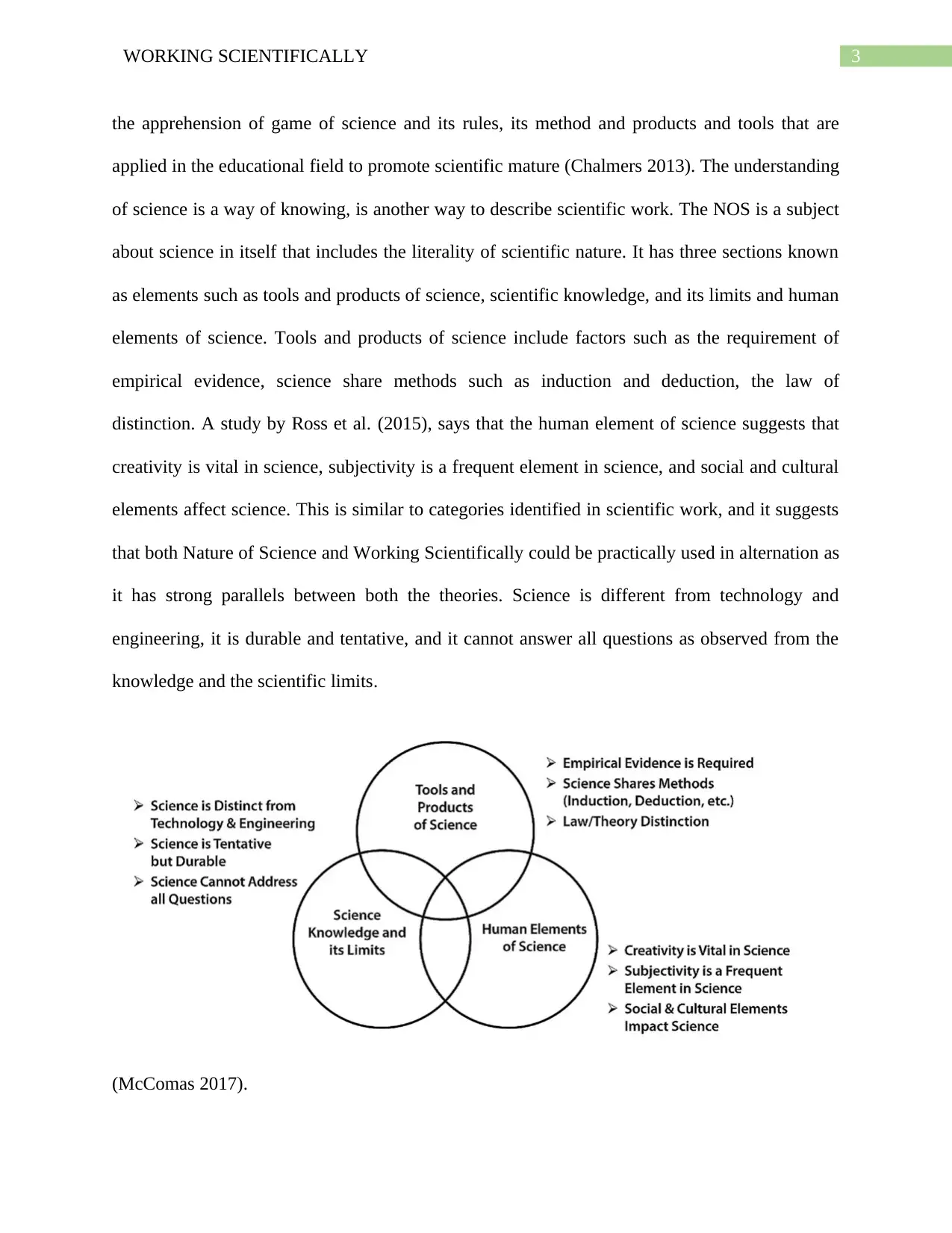
3WORKING SCIENTIFICALLY
the apprehension of game of science and its rules, its method and products and tools that are
applied in the educational field to promote scientific mature (Chalmers 2013). The understanding
of science is a way of knowing, is another way to describe scientific work. The NOS is a subject
about science in itself that includes the literality of scientific nature. It has three sections known
as elements such as tools and products of science, scientific knowledge, and its limits and human
elements of science. Tools and products of science include factors such as the requirement of
empirical evidence, science share methods such as induction and deduction, the law of
distinction. A study by Ross et al. (2015), says that the human element of science suggests that
creativity is vital in science, subjectivity is a frequent element in science, and social and cultural
elements affect science. This is similar to categories identified in scientific work, and it suggests
that both Nature of Science and Working Scientifically could be practically used in alternation as
it has strong parallels between both the theories. Science is different from technology and
engineering, it is durable and tentative, and it cannot answer all questions as observed from the
knowledge and the scientific limits.
(McComas 2017).
the apprehension of game of science and its rules, its method and products and tools that are
applied in the educational field to promote scientific mature (Chalmers 2013). The understanding
of science is a way of knowing, is another way to describe scientific work. The NOS is a subject
about science in itself that includes the literality of scientific nature. It has three sections known
as elements such as tools and products of science, scientific knowledge, and its limits and human
elements of science. Tools and products of science include factors such as the requirement of
empirical evidence, science share methods such as induction and deduction, the law of
distinction. A study by Ross et al. (2015), says that the human element of science suggests that
creativity is vital in science, subjectivity is a frequent element in science, and social and cultural
elements affect science. This is similar to categories identified in scientific work, and it suggests
that both Nature of Science and Working Scientifically could be practically used in alternation as
it has strong parallels between both the theories. Science is different from technology and
engineering, it is durable and tentative, and it cannot answer all questions as observed from the
knowledge and the scientific limits.
(McComas 2017).
Secure Best Marks with AI Grader
Need help grading? Try our AI Grader for instant feedback on your assignments.
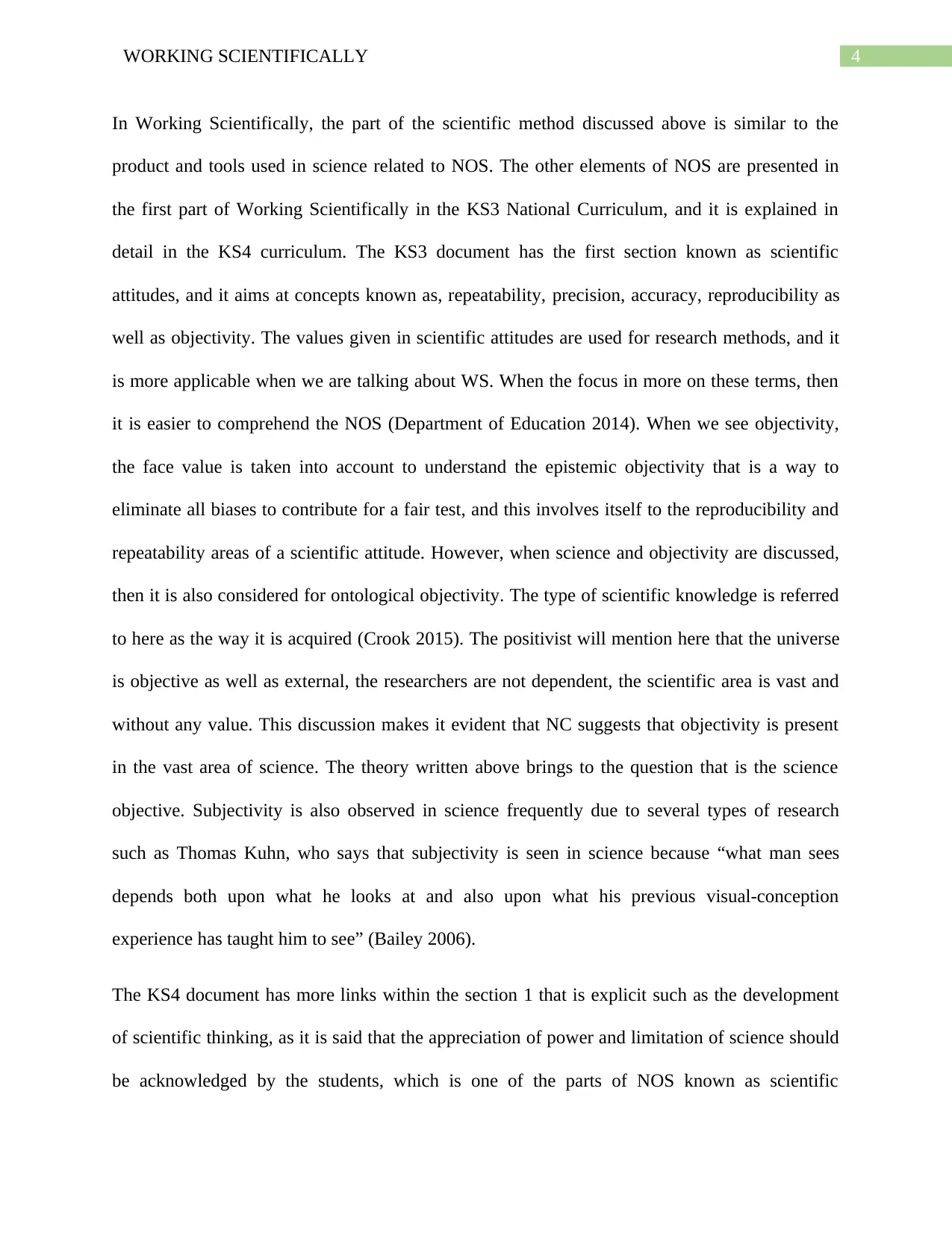
4WORKING SCIENTIFICALLY
In Working Scientifically, the part of the scientific method discussed above is similar to the
product and tools used in science related to NOS. The other elements of NOS are presented in
the first part of Working Scientifically in the KS3 National Curriculum, and it is explained in
detail in the KS4 curriculum. The KS3 document has the first section known as scientific
attitudes, and it aims at concepts known as, repeatability, precision, accuracy, reproducibility as
well as objectivity. The values given in scientific attitudes are used for research methods, and it
is more applicable when we are talking about WS. When the focus in more on these terms, then
it is easier to comprehend the NOS (Department of Education 2014). When we see objectivity,
the face value is taken into account to understand the epistemic objectivity that is a way to
eliminate all biases to contribute for a fair test, and this involves itself to the reproducibility and
repeatability areas of a scientific attitude. However, when science and objectivity are discussed,
then it is also considered for ontological objectivity. The type of scientific knowledge is referred
to here as the way it is acquired (Crook 2015). The positivist will mention here that the universe
is objective as well as external, the researchers are not dependent, the scientific area is vast and
without any value. This discussion makes it evident that NC suggests that objectivity is present
in the vast area of science. The theory written above brings to the question that is the science
objective. Subjectivity is also observed in science frequently due to several types of research
such as Thomas Kuhn, who says that subjectivity is seen in science because “what man sees
depends both upon what he looks at and also upon what his previous visual-conception
experience has taught him to see” (Bailey 2006).
The KS4 document has more links within the section 1 that is explicit such as the development
of scientific thinking, as it is said that the appreciation of power and limitation of science should
be acknowledged by the students, which is one of the parts of NOS known as scientific
In Working Scientifically, the part of the scientific method discussed above is similar to the
product and tools used in science related to NOS. The other elements of NOS are presented in
the first part of Working Scientifically in the KS3 National Curriculum, and it is explained in
detail in the KS4 curriculum. The KS3 document has the first section known as scientific
attitudes, and it aims at concepts known as, repeatability, precision, accuracy, reproducibility as
well as objectivity. The values given in scientific attitudes are used for research methods, and it
is more applicable when we are talking about WS. When the focus in more on these terms, then
it is easier to comprehend the NOS (Department of Education 2014). When we see objectivity,
the face value is taken into account to understand the epistemic objectivity that is a way to
eliminate all biases to contribute for a fair test, and this involves itself to the reproducibility and
repeatability areas of a scientific attitude. However, when science and objectivity are discussed,
then it is also considered for ontological objectivity. The type of scientific knowledge is referred
to here as the way it is acquired (Crook 2015). The positivist will mention here that the universe
is objective as well as external, the researchers are not dependent, the scientific area is vast and
without any value. This discussion makes it evident that NC suggests that objectivity is present
in the vast area of science. The theory written above brings to the question that is the science
objective. Subjectivity is also observed in science frequently due to several types of research
such as Thomas Kuhn, who says that subjectivity is seen in science because “what man sees
depends both upon what he looks at and also upon what his previous visual-conception
experience has taught him to see” (Bailey 2006).
The KS4 document has more links within the section 1 that is explicit such as the development
of scientific thinking, as it is said that the appreciation of power and limitation of science should
be acknowledged by the students, which is one of the parts of NOS known as scientific
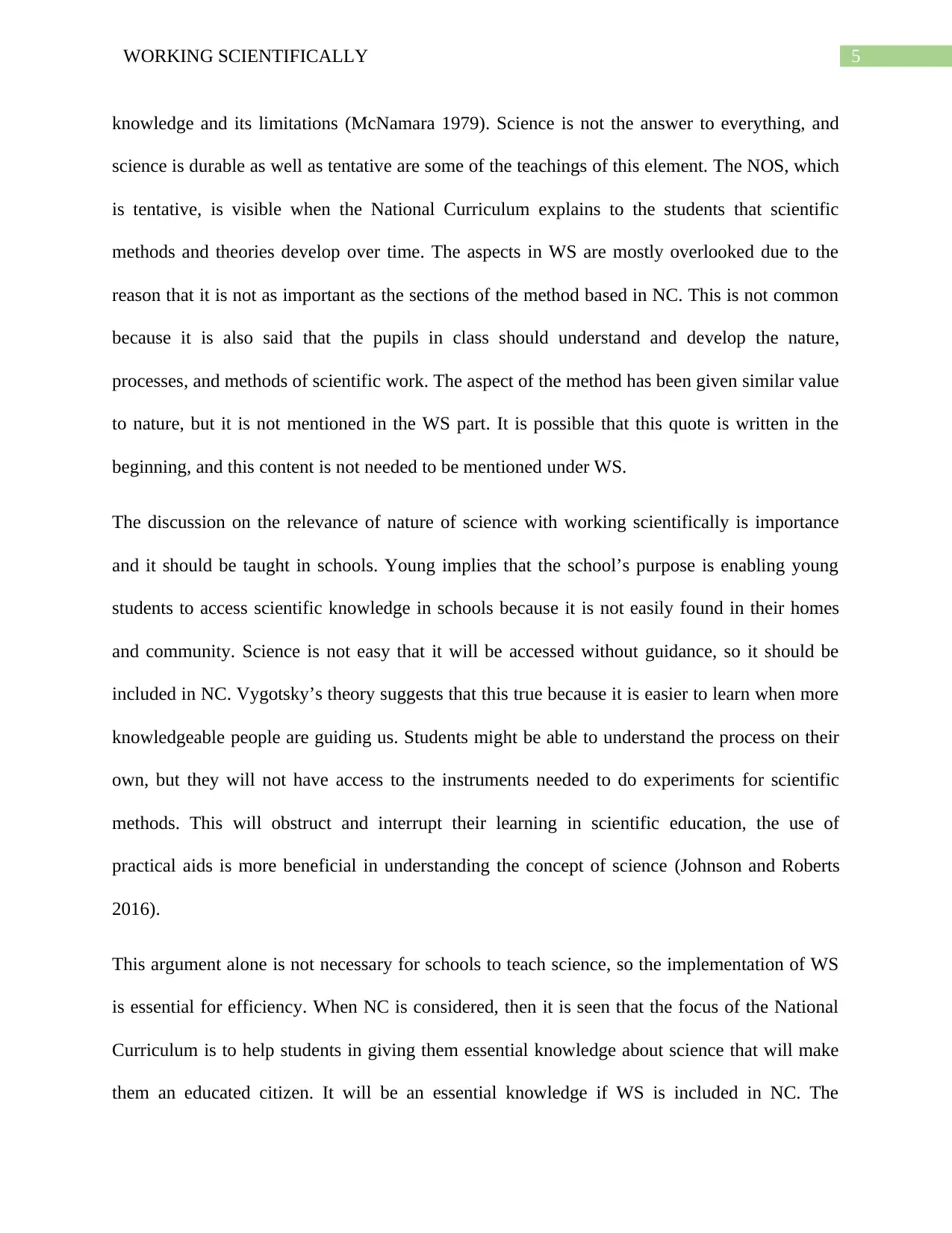
5WORKING SCIENTIFICALLY
knowledge and its limitations (McNamara 1979). Science is not the answer to everything, and
science is durable as well as tentative are some of the teachings of this element. The NOS, which
is tentative, is visible when the National Curriculum explains to the students that scientific
methods and theories develop over time. The aspects in WS are mostly overlooked due to the
reason that it is not as important as the sections of the method based in NC. This is not common
because it is also said that the pupils in class should understand and develop the nature,
processes, and methods of scientific work. The aspect of the method has been given similar value
to nature, but it is not mentioned in the WS part. It is possible that this quote is written in the
beginning, and this content is not needed to be mentioned under WS.
The discussion on the relevance of nature of science with working scientifically is importance
and it should be taught in schools. Young implies that the school’s purpose is enabling young
students to access scientific knowledge in schools because it is not easily found in their homes
and community. Science is not easy that it will be accessed without guidance, so it should be
included in NC. Vygotsky’s theory suggests that this true because it is easier to learn when more
knowledgeable people are guiding us. Students might be able to understand the process on their
own, but they will not have access to the instruments needed to do experiments for scientific
methods. This will obstruct and interrupt their learning in scientific education, the use of
practical aids is more beneficial in understanding the concept of science (Johnson and Roberts
2016).
This argument alone is not necessary for schools to teach science, so the implementation of WS
is essential for efficiency. When NC is considered, then it is seen that the focus of the National
Curriculum is to help students in giving them essential knowledge about science that will make
them an educated citizen. It will be an essential knowledge if WS is included in NC. The
knowledge and its limitations (McNamara 1979). Science is not the answer to everything, and
science is durable as well as tentative are some of the teachings of this element. The NOS, which
is tentative, is visible when the National Curriculum explains to the students that scientific
methods and theories develop over time. The aspects in WS are mostly overlooked due to the
reason that it is not as important as the sections of the method based in NC. This is not common
because it is also said that the pupils in class should understand and develop the nature,
processes, and methods of scientific work. The aspect of the method has been given similar value
to nature, but it is not mentioned in the WS part. It is possible that this quote is written in the
beginning, and this content is not needed to be mentioned under WS.
The discussion on the relevance of nature of science with working scientifically is importance
and it should be taught in schools. Young implies that the school’s purpose is enabling young
students to access scientific knowledge in schools because it is not easily found in their homes
and community. Science is not easy that it will be accessed without guidance, so it should be
included in NC. Vygotsky’s theory suggests that this true because it is easier to learn when more
knowledgeable people are guiding us. Students might be able to understand the process on their
own, but they will not have access to the instruments needed to do experiments for scientific
methods. This will obstruct and interrupt their learning in scientific education, the use of
practical aids is more beneficial in understanding the concept of science (Johnson and Roberts
2016).
This argument alone is not necessary for schools to teach science, so the implementation of WS
is essential for efficiency. When NC is considered, then it is seen that the focus of the National
Curriculum is to help students in giving them essential knowledge about science that will make
them an educated citizen. It will be an essential knowledge if WS is included in NC. The
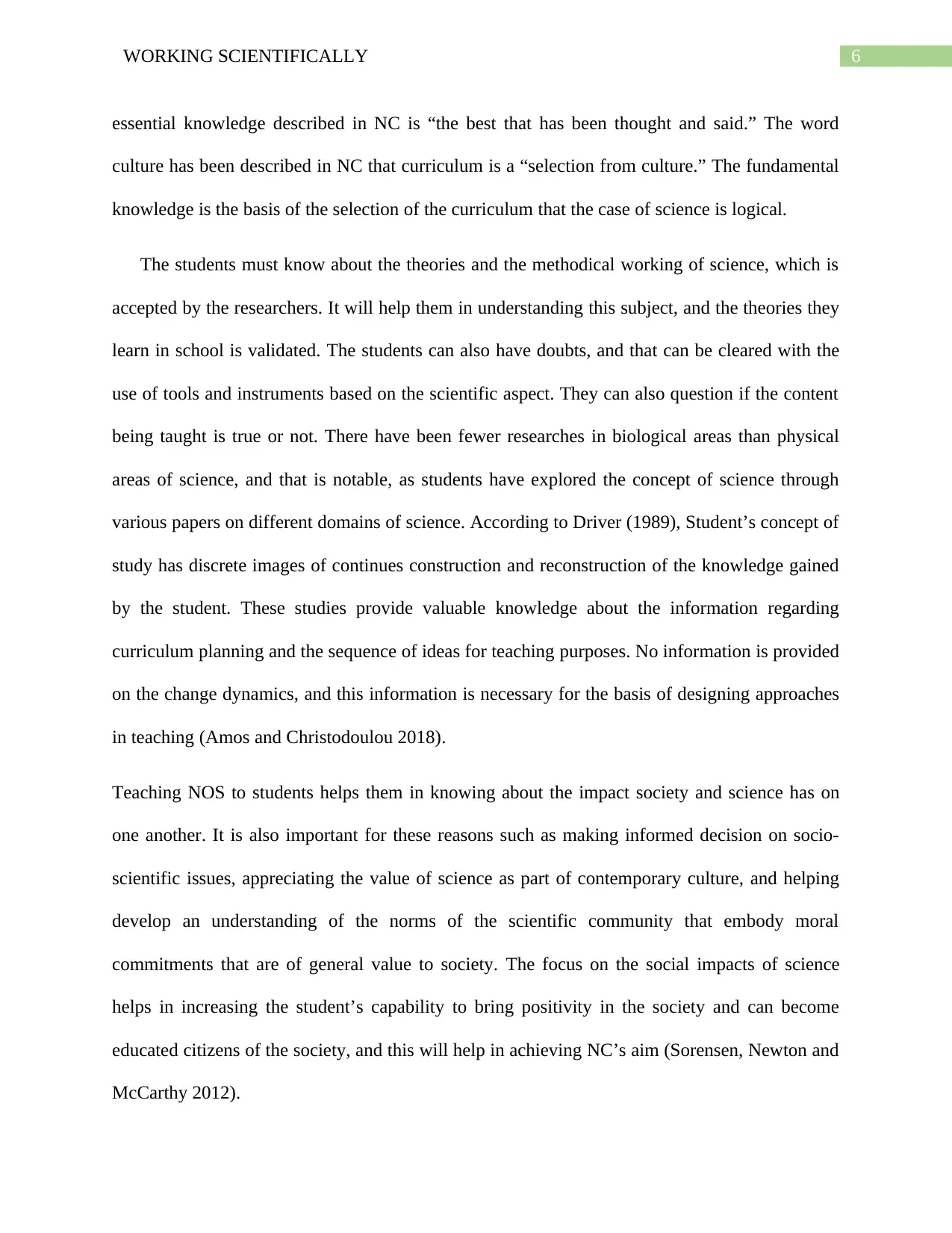
6WORKING SCIENTIFICALLY
essential knowledge described in NC is “the best that has been thought and said.” The word
culture has been described in NC that curriculum is a “selection from culture.” The fundamental
knowledge is the basis of the selection of the curriculum that the case of science is logical.
The students must know about the theories and the methodical working of science, which is
accepted by the researchers. It will help them in understanding this subject, and the theories they
learn in school is validated. The students can also have doubts, and that can be cleared with the
use of tools and instruments based on the scientific aspect. They can also question if the content
being taught is true or not. There have been fewer researches in biological areas than physical
areas of science, and that is notable, as students have explored the concept of science through
various papers on different domains of science. According to Driver (1989), Student’s concept of
study has discrete images of continues construction and reconstruction of the knowledge gained
by the student. These studies provide valuable knowledge about the information regarding
curriculum planning and the sequence of ideas for teaching purposes. No information is provided
on the change dynamics, and this information is necessary for the basis of designing approaches
in teaching (Amos and Christodoulou 2018).
Teaching NOS to students helps them in knowing about the impact society and science has on
one another. It is also important for these reasons such as making informed decision on socio-
scientific issues, appreciating the value of science as part of contemporary culture, and helping
develop an understanding of the norms of the scientific community that embody moral
commitments that are of general value to society. The focus on the social impacts of science
helps in increasing the student’s capability to bring positivity in the society and can become
educated citizens of the society, and this will help in achieving NC’s aim (Sorensen, Newton and
McCarthy 2012).
essential knowledge described in NC is “the best that has been thought and said.” The word
culture has been described in NC that curriculum is a “selection from culture.” The fundamental
knowledge is the basis of the selection of the curriculum that the case of science is logical.
The students must know about the theories and the methodical working of science, which is
accepted by the researchers. It will help them in understanding this subject, and the theories they
learn in school is validated. The students can also have doubts, and that can be cleared with the
use of tools and instruments based on the scientific aspect. They can also question if the content
being taught is true or not. There have been fewer researches in biological areas than physical
areas of science, and that is notable, as students have explored the concept of science through
various papers on different domains of science. According to Driver (1989), Student’s concept of
study has discrete images of continues construction and reconstruction of the knowledge gained
by the student. These studies provide valuable knowledge about the information regarding
curriculum planning and the sequence of ideas for teaching purposes. No information is provided
on the change dynamics, and this information is necessary for the basis of designing approaches
in teaching (Amos and Christodoulou 2018).
Teaching NOS to students helps them in knowing about the impact society and science has on
one another. It is also important for these reasons such as making informed decision on socio-
scientific issues, appreciating the value of science as part of contemporary culture, and helping
develop an understanding of the norms of the scientific community that embody moral
commitments that are of general value to society. The focus on the social impacts of science
helps in increasing the student’s capability to bring positivity in the society and can become
educated citizens of the society, and this will help in achieving NC’s aim (Sorensen, Newton and
McCarthy 2012).
Paraphrase This Document
Need a fresh take? Get an instant paraphrase of this document with our AI Paraphraser
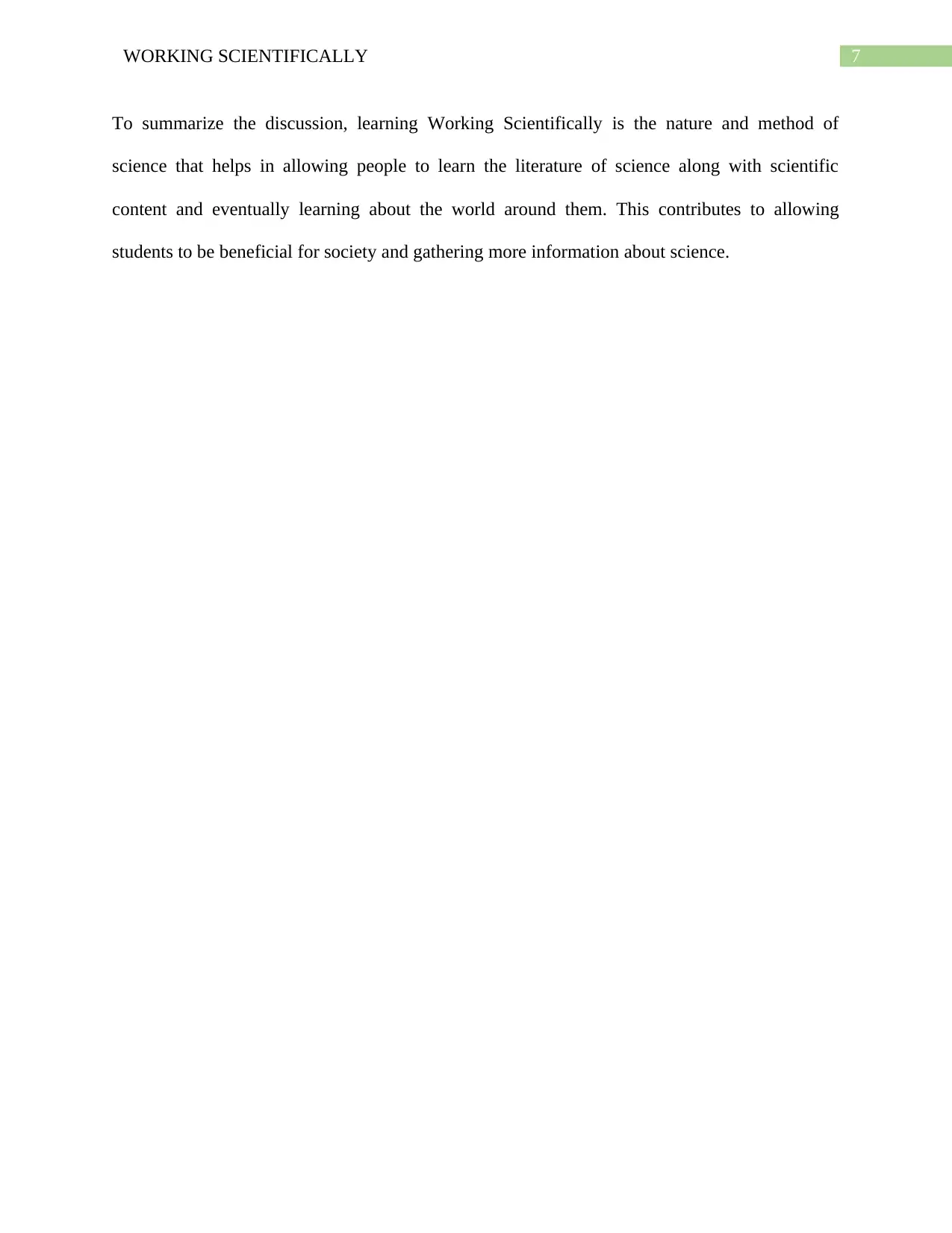
7WORKING SCIENTIFICALLY
To summarize the discussion, learning Working Scientifically is the nature and method of
science that helps in allowing people to learn the literature of science along with scientific
content and eventually learning about the world around them. This contributes to allowing
students to be beneficial for society and gathering more information about science.
To summarize the discussion, learning Working Scientifically is the nature and method of
science that helps in allowing people to learn the literature of science along with scientific
content and eventually learning about the world around them. This contributes to allowing
students to be beneficial for society and gathering more information about science.
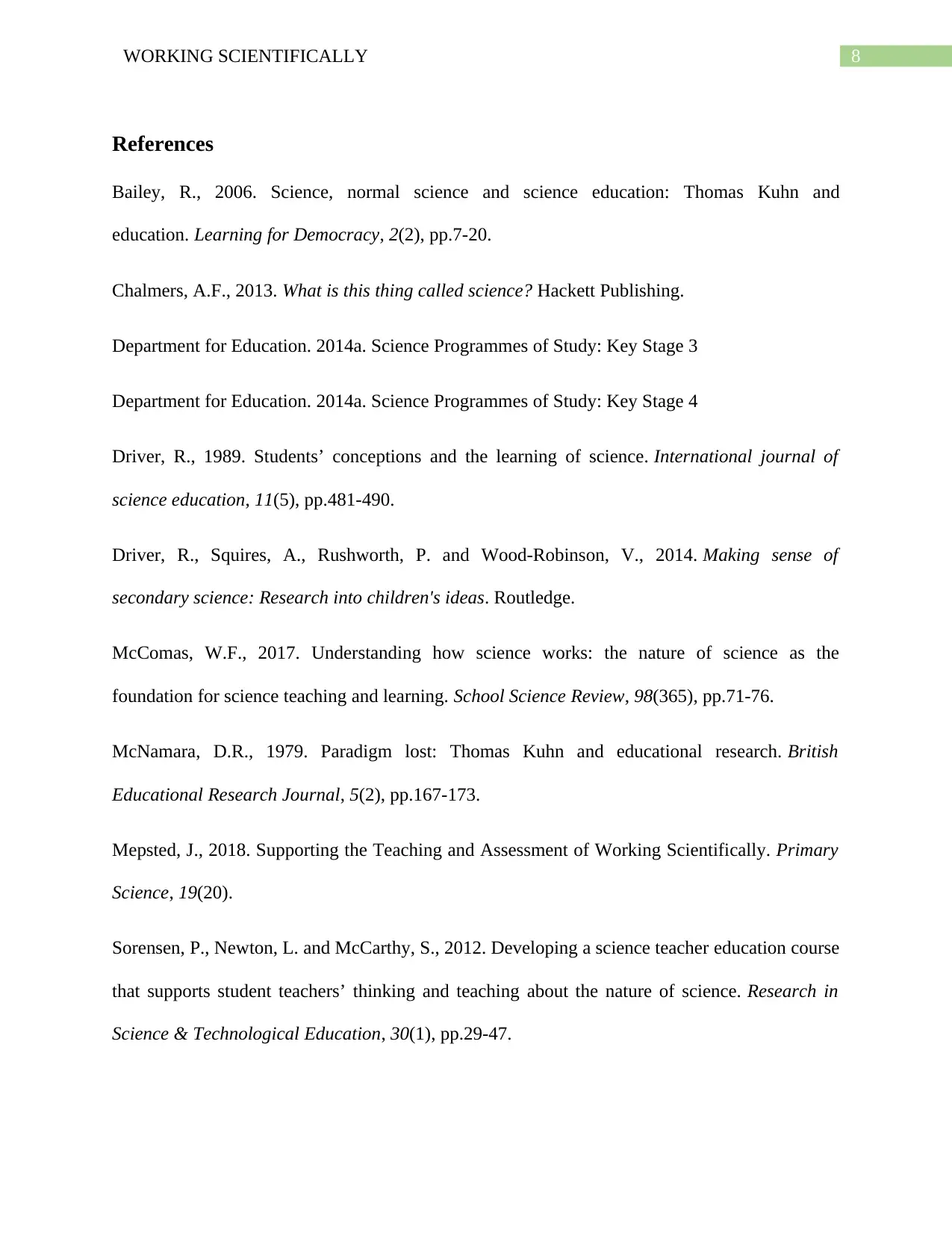
8WORKING SCIENTIFICALLY
References
Bailey, R., 2006. Science, normal science and science education: Thomas Kuhn and
education. Learning for Democracy, 2(2), pp.7-20.
Chalmers, A.F., 2013. What is this thing called science? Hackett Publishing.
Department for Education. 2014a. Science Programmes of Study: Key Stage 3
Department for Education. 2014a. Science Programmes of Study: Key Stage 4
Driver, R., 1989. Students’ conceptions and the learning of science. International journal of
science education, 11(5), pp.481-490.
Driver, R., Squires, A., Rushworth, P. and Wood-Robinson, V., 2014. Making sense of
secondary science: Research into children's ideas. Routledge.
McComas, W.F., 2017. Understanding how science works: the nature of science as the
foundation for science teaching and learning. School Science Review, 98(365), pp.71-76.
McNamara, D.R., 1979. Paradigm lost: Thomas Kuhn and educational research. British
Educational Research Journal, 5(2), pp.167-173.
Mepsted, J., 2018. Supporting the Teaching and Assessment of Working Scientifically. Primary
Science, 19(20).
Sorensen, P., Newton, L. and McCarthy, S., 2012. Developing a science teacher education course
that supports student teachers’ thinking and teaching about the nature of science. Research in
Science & Technological Education, 30(1), pp.29-47.
References
Bailey, R., 2006. Science, normal science and science education: Thomas Kuhn and
education. Learning for Democracy, 2(2), pp.7-20.
Chalmers, A.F., 2013. What is this thing called science? Hackett Publishing.
Department for Education. 2014a. Science Programmes of Study: Key Stage 3
Department for Education. 2014a. Science Programmes of Study: Key Stage 4
Driver, R., 1989. Students’ conceptions and the learning of science. International journal of
science education, 11(5), pp.481-490.
Driver, R., Squires, A., Rushworth, P. and Wood-Robinson, V., 2014. Making sense of
secondary science: Research into children's ideas. Routledge.
McComas, W.F., 2017. Understanding how science works: the nature of science as the
foundation for science teaching and learning. School Science Review, 98(365), pp.71-76.
McNamara, D.R., 1979. Paradigm lost: Thomas Kuhn and educational research. British
Educational Research Journal, 5(2), pp.167-173.
Mepsted, J., 2018. Supporting the Teaching and Assessment of Working Scientifically. Primary
Science, 19(20).
Sorensen, P., Newton, L. and McCarthy, S., 2012. Developing a science teacher education course
that supports student teachers’ thinking and teaching about the nature of science. Research in
Science & Technological Education, 30(1), pp.29-47.
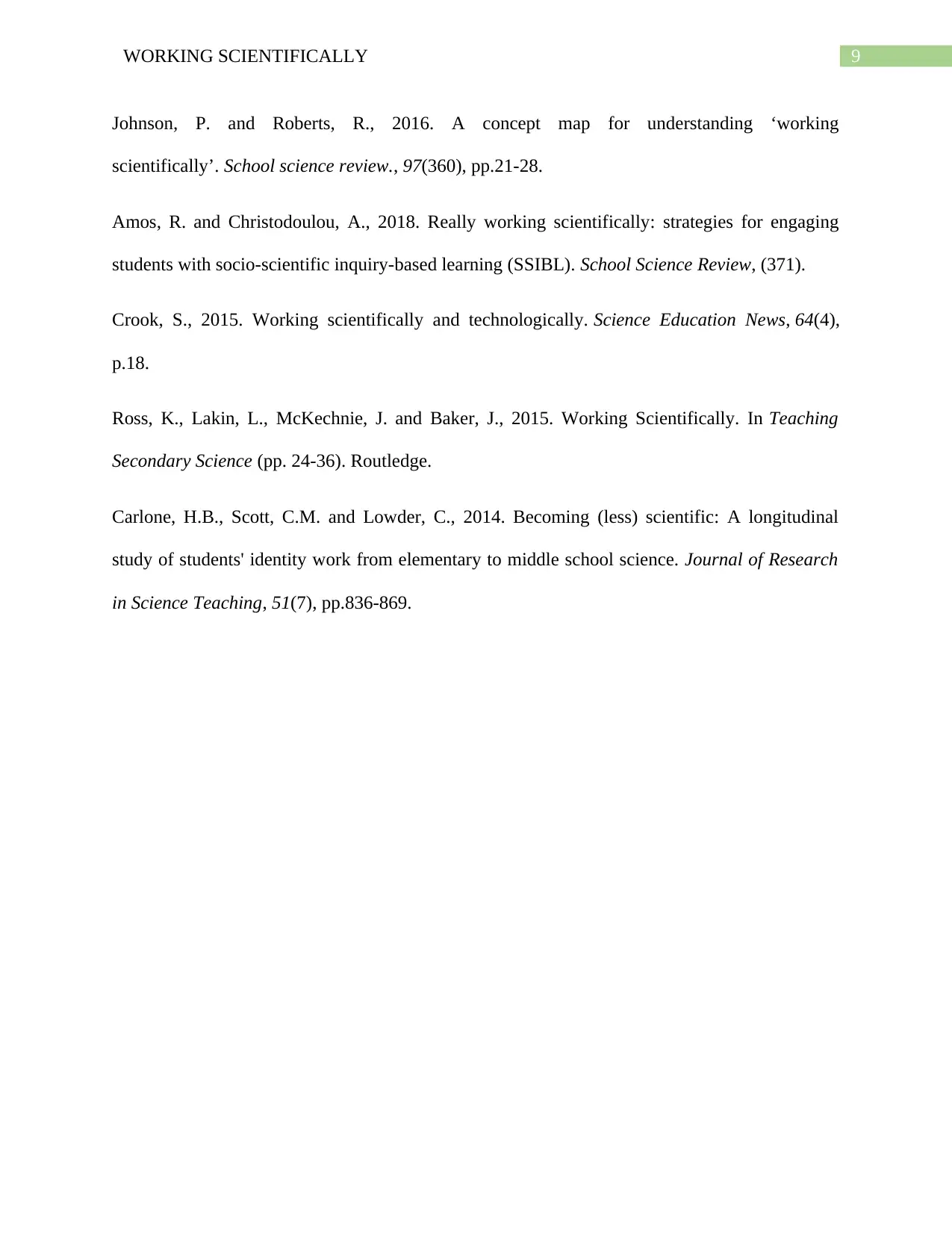
9WORKING SCIENTIFICALLY
Johnson, P. and Roberts, R., 2016. A concept map for understanding ‘working
scientifically’. School science review., 97(360), pp.21-28.
Amos, R. and Christodoulou, A., 2018. Really working scientifically: strategies for engaging
students with socio-scientific inquiry-based learning (SSIBL). School Science Review, (371).
Crook, S., 2015. Working scientifically and technologically. Science Education News, 64(4),
p.18.
Ross, K., Lakin, L., McKechnie, J. and Baker, J., 2015. Working Scientifically. In Teaching
Secondary Science (pp. 24-36). Routledge.
Carlone, H.B., Scott, C.M. and Lowder, C., 2014. Becoming (less) scientific: A longitudinal
study of students' identity work from elementary to middle school science. Journal of Research
in Science Teaching, 51(7), pp.836-869.
Johnson, P. and Roberts, R., 2016. A concept map for understanding ‘working
scientifically’. School science review., 97(360), pp.21-28.
Amos, R. and Christodoulou, A., 2018. Really working scientifically: strategies for engaging
students with socio-scientific inquiry-based learning (SSIBL). School Science Review, (371).
Crook, S., 2015. Working scientifically and technologically. Science Education News, 64(4),
p.18.
Ross, K., Lakin, L., McKechnie, J. and Baker, J., 2015. Working Scientifically. In Teaching
Secondary Science (pp. 24-36). Routledge.
Carlone, H.B., Scott, C.M. and Lowder, C., 2014. Becoming (less) scientific: A longitudinal
study of students' identity work from elementary to middle school science. Journal of Research
in Science Teaching, 51(7), pp.836-869.
1 out of 10
Related Documents
Your All-in-One AI-Powered Toolkit for Academic Success.
+13062052269
info@desklib.com
Available 24*7 on WhatsApp / Email
![[object Object]](/_next/static/media/star-bottom.7253800d.svg)
Unlock your academic potential
© 2024 | Zucol Services PVT LTD | All rights reserved.





